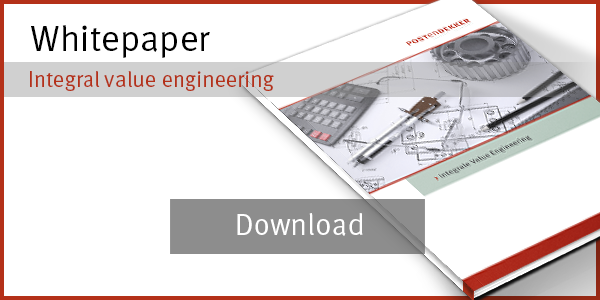
Integral value engineering is an excellent way to realise cost price reduction and/or optimisation of existing products. This way, you can stay competitive relatively easy and cheap.
In this article, I will give you five tips that will help you to successfully develop and launch your value engineering project.
Integral value engineering is a method to reduce your cost price while retaining the market value of your product. The focus here is on the reduction of integral costs while ensuring form-fit-function, minimal time for requalification and a short pay-back period of the effort.
Previously, we wrote about what integral value engineering exactly entails, how you determine if value engineering is interesting for your organisation, how you can identify such a project and, finally, how to organise your value engineering project. I am happy to give you several tips regarding value engineering.
Download the whitepaper 'Integral value engineering'
Tip 1: put focus on solutions for which you don’t need or need only limited requalification
Big advantage of the use of your existing product as starting point, is that this has already been qualified and accepted. All necessary (endurance)tests, validations and convictions, that you need to have this product accepted, have already carried been carried out. Just think about how much time this has cost for your present product. It can easily take months or even years.
Are you looking for a quick result? Then keep the core of the product the same and focus only on implementation of improvements of how it is made, assembled or sold. A good example is a cleverly designed assembly tool that ensures saving of time during assembly while the product remains the same.
Tip 2: isolate the project and collect ideas from within the organisation
Because the core of the product stays the same, less people need to be actively involved in the project. It is not immediately necessary to do research and hold meetings about what a client might want, what is standard and what is optional, and how the product should be implemented in SAP. Make use of this!
A small core team is quick, energetic, and focused on the ultimate objective. Involve the rest of the organisation through brainstorm sessions and secure the acceptation through presentations of the progress that’s been made. An underestimated, but very important aspect for this sort of brainstorm sessions is preparation. Make sure that during the brainstorm you have at hand all information regarding the present costs of the design and the way it is made and sold. This allows that during the brainstorms, you can only think collectively about key parts, adaptations and processes.
Tip 3: create a possibility for practical research
Just like many people find it hard to judge a new house based on a floor plan, there are people who find it difficult to judge an idea based on a PowerPoint presentation. The strength of a physical product of a component of a product helps with assessing the potential for cost price production. In addition, it stimulates people to think about what this idea concretely means for their process, client, or employees.
Present techniques such as 3D printing and scanning, are extremely accessible for quickly adapting and optimising and make ideas concrete. Make sure these possibilities are used.
Tip 4: total saving from small ideas leads to a good result
It rarely concerns just one big idea with which you obtain a radical improvement of the cost price. Usually, many smaller ideas and actions together make sure there is a significant saving. It is therefore important to seriously consider these smaller ideas. Keep checking the accumulated saving and effort to achieve a significant reduction in cost price.
Tip 5: weight reduction is the low-hanging fruit
During the development of a new product, the focus is usually on creating customer-value and minimising risks. The safe route is often taken here, and many components are often dimensioned. Because there is often a direct relationship between the weight of the product and component costs, a potential saving is often easier to assess. You just divide the price of the present component by its weight and use this number as the prefix, in order to assess a lighter design in terms of costs.
Besides cost reduction by reduction of material, lighter components in the assembly can be positioned and assembled quicker and easier. This often creates an additional cost reduction due to the saving of time. With an EEM analysis, you can simply analyse the strengths of your present design and determine quickly where to find excess material with which you can instantly save money.
Would you like more tips and/or want to know everything about Value Engineering? Then download the whitepaper below!











